Fashion in the 1950s After the War
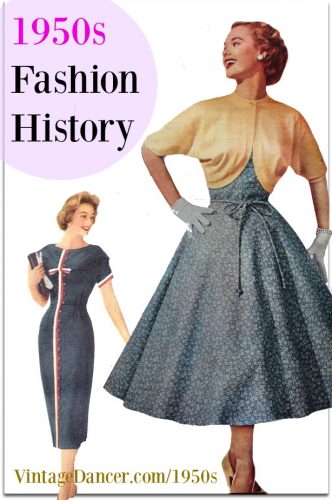
1950s fashion history. Office one of xx in depth looks at women'due south and men's fashion of the fifties.
Today we commencement a new series all nearly 1950s fashion. I have written a number of articles on 1950s women'southward way already, but now it'due south time to pull them all together, add the missing elements, and explore menswear, besides. Let us begin with an overview nearly 1950s women'southward fashion:
1950s Fashion History for Women
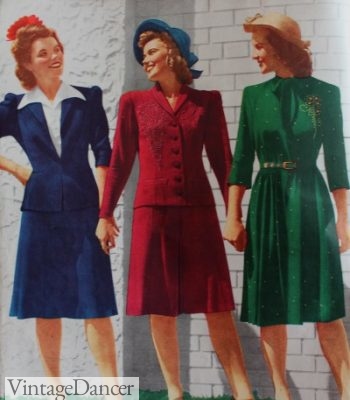
1943 Women's Fashions: Military inspired broad shoulders, puffed sleeves, masculine necklines, A-line skirts, and minimal decoration.
In many ways, the 1950s took a big step back, especially for women. During World War II, while the men were abroad, women began to proceeds an independence that was rare before the state of war. They left their homes to work in offices and factories, earning and managing their own money. Vesture was heavily restricted throughout and just afterwards the war — everything from the length of skirts to the size of collars was regulated. This resulted in a slim, straight silhouette. Women wore comfortable clothing like suits and shirtdresses, and even began to regularly wear pants, especially to work. They had to 'make practise and mend,' buying or sewing well-made clothing that had to last and fixing garments that were past their prime. Learn more than about 1940s women's fashions hither.
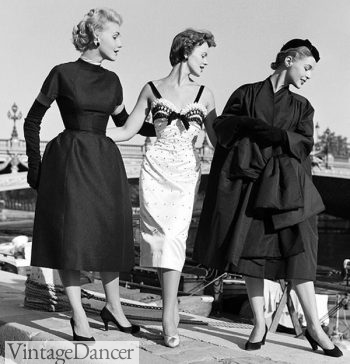
1953, Dior's New Wait Silhouettes
In 1947, Christian Dior permanently changed the fashion industry, creating the look that would boss the next decade. Dubbed the 'New Wait' by Harper's Bazaar editor Carmel Snow, Dior's starting time fashion collection, shown in Paris, was the verbal reverse of the '40s await. The textile was luxurious and voluminous. Shoulders were soft instead of squared, the effigy was hourglass instead of boxy, and the brusk, directly brim of the ration-happy '40s was replaced by a huge, billowing one that striking at mid-calf. There were also skirts that were so slim and fitted that women found it hard to walk. Bodices were extremely tight, accentuating a tiny waist.
The whole look was reminiscent of the mid-nineteenth century. To accomplish the await, women had to once once more clasp into some serious undergarments. A boned corset achieved the 'wasp waist,' and bosom and hip pads completed the hourglass figure.
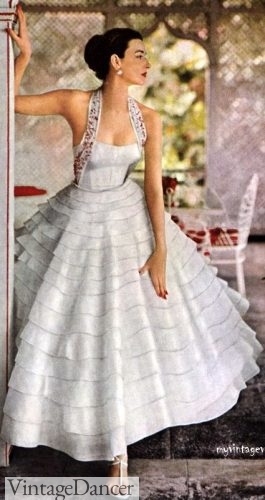
1953- The Large, Total Skirt with a Tight Bodice was Also the Silhouette of the 1850s (Victorian Era)
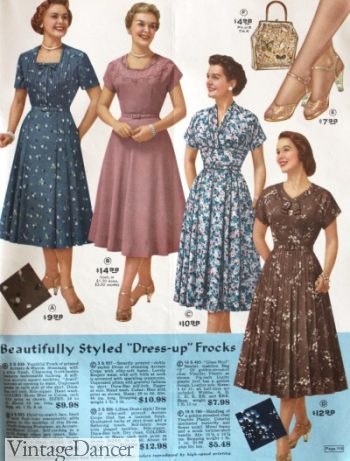
1959 Firm apparel by Lane Bryant, Plus Size Designer
Many women were outraged, particularly in the United States. Protests were held targeting Dior and his new clothing. Women had merely gained a large amount of equality and weren't ready to give it upwardly — both in work and in style. The new wearing apparel used excessive amounts of material, needed constant maintenance, and required a complete coordinated accessory drove to exist "perfect." However, afterwards the hardships of the war, everybody was ready for a change, and past the get-go of the '50s, everybody was wearing the New Expect.
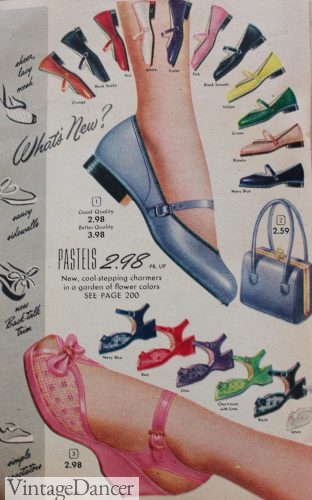
1952 Matching Your Shoes and Purse (and Belt, Hat, Gloves, and Jewelry) was Desired
As men returned habitation from the war, women also returned to the home every bit wives, mothers, and homemakers. There was a migration to newly-congenital suburbs where life was supposed to be picture-perfect and traditional. Society became very conservative, and at that place was a rise in affluence. Racism and anti-communism were rampant, and at that place was an air of enforced conformity – everyone wanted to human activity and await 'normal.' Even teenagers adopted formality during the school twenty-four hours, merely turned to new casual clothes on the weekend.
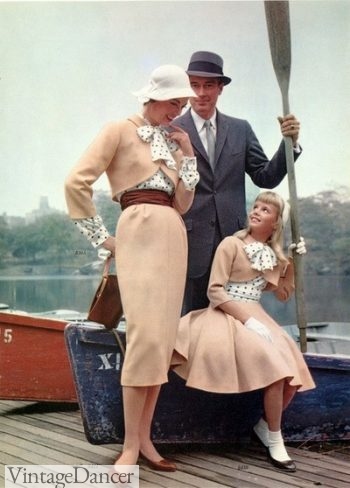
The Perfect 1950s Family
The human was the breadwinner and the woman was the feminine 'happy housewife.' Instead of scrimping and saving, women began to spend a lot of money on getting dressed. Their appearance was linked to their husband'southward success. Fifty-fifty if she was not wealthy, looking the function became an obsessive occupation. Radio, TV, and magazines reminded women daily of their demand to be beautiful for their husbands.
The New Wait
The full look of the 1950s was mature, glamorous, and very put-together. Dresses, skirts, and undergarments were constricting, simply a broad range of new 'leisure clothes' allowed people to dress casually at home. Women were expected to exist impeccably dressed and groomed in public or when their spouse was dwelling, always with coordinating hats, shoes, bags, belts, gloves, and jewelry. In privacy, women dressed much more just and comfortably. Eventually, these casual fashions became public habiliment also.
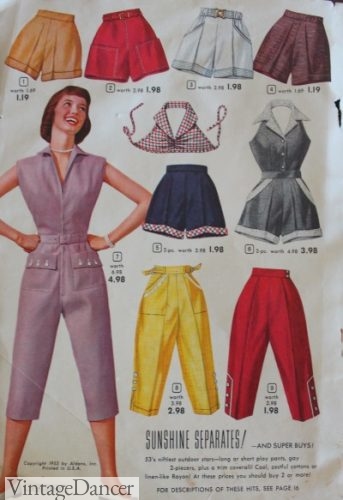
1954 Women'southward Casual, Sporty Dress
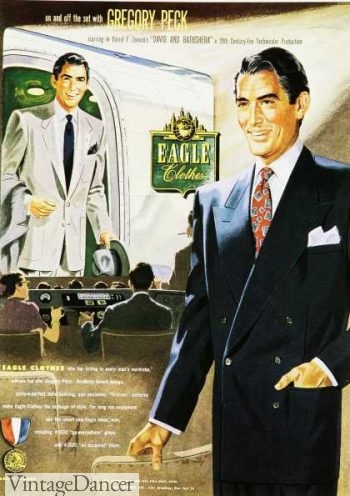
1950 Men's Way Suits were Bourgeois, notwithstanding Less Restrictive Than Previous Years
Men wore serious, somber business suits at their newly created office jobs, and leisure suits or slacks on weekends. Shoulders were broad and jackets were indigestible. They were also expected to exist well-groomed and put together, with suits and pants perfectly pressed. Read more than about 1950s men's fashion.
Paris, cut off from the earth during the war, once again became the center of fashion. Designers held fashion shows twice a year, and the U.South. and Britain often bought the rights to copy the garments (or simply stole the designs) and churned out cheaper versions to be sold in department stores.
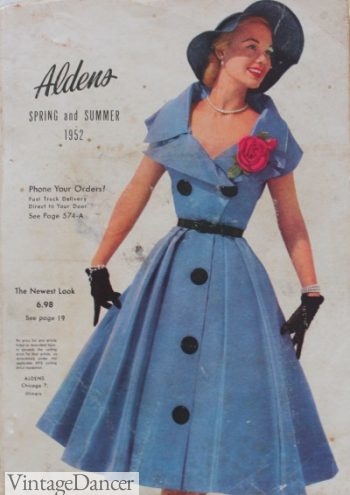
1952 Aldens Catalogs had the Latest Fashions at Affordable Mass Produced Prices
Mode magazines like Faddy, Women's Wear Daily, and postal service society catalogs had a sharp increase in production ad that brought designer fashions into every home. Thanks to the state of war efforts, the U.S. had made huge advancements in mass production techniques and used them to create new 'ready to wear' clothing. Everyone was able to wear the latest fashions.
Led by Dior, many designers started contracting out the manufacture of some clothing and a wide range of accessories that were stamped with their labels. Everything from perfume to gloves, hats, bags, and ties were 'branded' by the designers. This practice is widespread today, as you can encounter past visiting any department store, just was a new thought in the '50s. Dior also gear up boutiques all over the globe – another novel idea that is the norm in manner today.
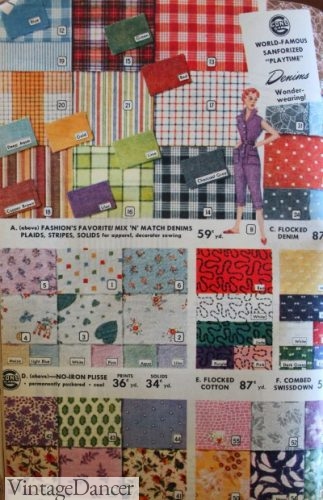
1953 Casual Denim and Cotton Prints for Home Sewing
Fabrics were ofttimes luxurious, especially for evening wear. Velvet, tulle, silk, and satin were popular. Cotton fiber and wool were often used for daywear, along with new synthetic fabrics. Polyester and rayon were used to make all kinds of clothing, from blouses and men's shirts to dresses and suits.
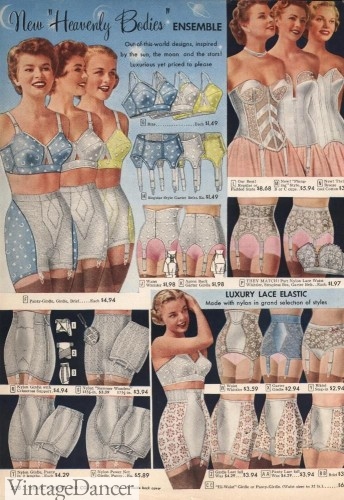
1958 Panty Girdles, Bras, and Garters
Nylon and rubberband, conserved for the war endeavour, began to be used for a wide diverseness of clothing, especially undergarments. These fabrics were made into delicate underwear, nightgowns, and stockings. Nylon did such a skillful job of replacing silk stockings that they've been known ever since equally simply 'nylons.'
These new constructed fabrics were seen as 'phenomenon fabrics.' They could be washed and dried easily, didn't need to be ironed, and didn't shrink.
Few designers chose to break from the New Look model, but a couple paved the way. Coco Chanel hated the New Look so much that she reopened her business after endmost it at the kickoff of the state of war. In 1954, she came dorsum with slim suits – the make's signature look – in wools and tweeds. Jackets were boxy with no collar, and skirts were straight and comfortable. She topped the look off with costume jewelry and the famous quilted handbag.
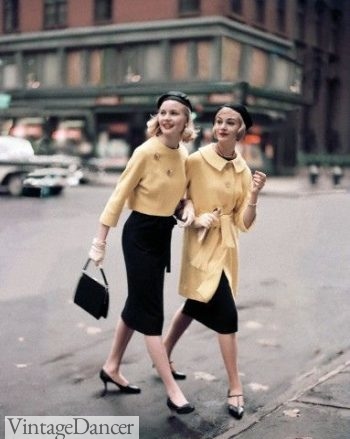
Chanel Way Clothing of 1958
Hubert de Givenchy unveiled his 'sack clothes' in 1957. It was completely loose, taking the emphasis away from the waist entirely. It was to be the inspiration for the iconic tunic dresses of the 1960s.
The conformity of the '50s somewhen backfired. Young people everywhere grew cynical, and the happy housewives started to feel trapped (at that place was a dramatic rise in the use of sedatives and anti-depressants during the '50s).
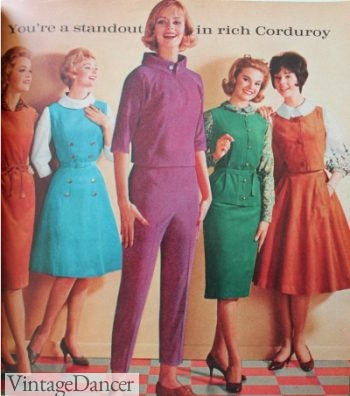
The 1960s: More Pants, Looser Tops, Shorter Skirts. Freedom in Moderation.
The New Look lasted throughout the 1950s, merely the high-maintenance lifestyle somewhen gave style to the rebellious civilization in the '60s. Teenagers wanted to be individuals who didn't await like their parents, and their mothers were ready to pause complimentary over again. Fads were curt-lived and garments were cheaply fabricated. Clothing wasn't constrictive anymore, and was looser and much shorter. The flowing hippie await and the graphic mini-skirt gave women choices and in the way they expressed themselves.
Read More
- 1960s Women's Fashions
- 1950s Teenager Fashion
- Fabrics and Colors in 1950s Fashion
- 1950s Fashion Guide for Women
- xx 1950s Outfit Ideas
0 Response to "Fashion in the 1950s After the War"
Post a Comment